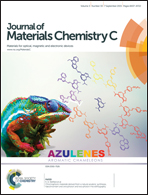Eu3+ luminescence from different sites in a scheelite-type cadmium molybdate red phosphor with vacancies
Abstract
Eu3+-doped scheelite-type cadmium molybdate with the chemical formula Cd1−3xEu2x□xMoO4 (vacancy is denoted by □) was investigated as a red-emitting conversion phosphor for white light emitting diodes (WLEDs) by taking advantage of the Eu3+ spectroscopic probe to analyze in detail the structural properties as a continuation of our previous analysis on both, Cd1−3xNd2x□xMoO4 and Cd1−3xYb2x□xMoO4. A series of microcrystalline samples were synthesized using a high-temperature solid state reaction. X-ray diffraction patterns indicate that the samples show only one phase and crystallize in the tetragonal scheelite-type structure (space group I41/a with point symmetry S4), when the concentration of Eu3+ ions is in the range from 0.05 mol% to 66.67 mol% with respect to Cd2+ ions. Substitution of divalent Cd2+ by trivalent Eu3+ cations leads to the formation of cationic vacancies in the framework due to the charge compensation: 3Cd2+ → 2Eu3+ + □ vacancy. The □ vacancy concentration dependence brings some originality to this research program in optical materials. High-resolution photoluminescence excitation and emission spectra were investigated. Time-resolved laser spectroscopy performed at room temperature and at 77 K allowed the separation of lines corresponding to transitions from the 5D1 and 5D0 levels, respectively, and to define the contributions of the individual emission lines in the steady state spectrum. Low temperature fluorescence spectra obtained by applying laser site-selective excitation confirmed the presence of multisite characteristics of Eu3+ ions in this host lattice, similar to that found for Nd3+ and Yb3+ dopants. Three types of Eu3+ sites have been identified. These phosphors are efficiently excited by UV light, and exhibit a very strong red luminescence corresponding mainly to the electric dipole 5D0 → 7F2 transition at 616 nm, and thus they are considered as promising phosphors for WLEDs. Concentration quenching of Eu3+ luminescence as well as the optimum doping of optically active ions were investigated.


 Please wait while we load your content...
Please wait while we load your content...